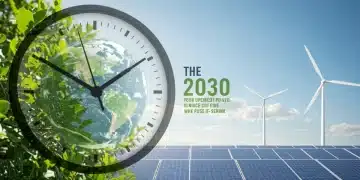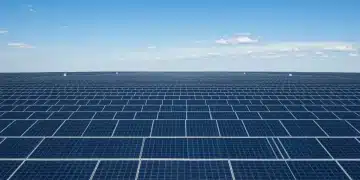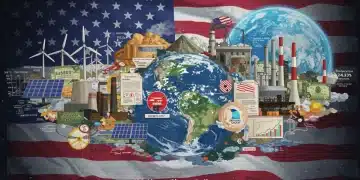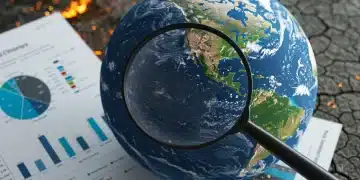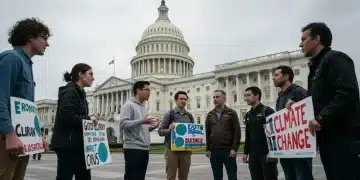Act Now: US Renewable Energy Transition Critical in Next 12 Months
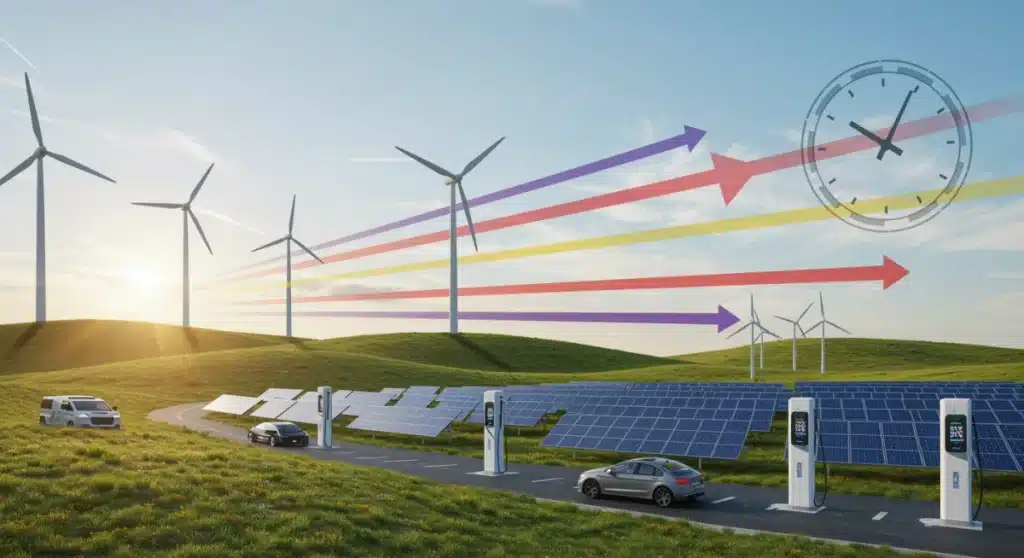
The U.S. must accelerate its renewable energy transition within the next 12 months to meet pressing climate goals, requiring swift policy implementation and significant infrastructure investment.
As of today, the call to Act Now: The Next 12 Months Are Critical for U.S. Renewable Energy Transition Goals (TIME-SENSITIVE) resonates with unprecedented urgency. The nation stands at a pivotal juncture, where decisions made and actions taken in the coming year will profoundly shape the trajectory of its climate future and energy independence. Will the United States seize this moment to solidify its commitment to clean energy?
The Immediate Imperative: Why 12 Months Matter
The next 12 months represent a crucial period for the U.S. renewable energy transition. Experts and policymakers are emphasizing the need for rapid acceleration in deployment and policy implementation to meet ambitious climate targets and avoid irreversible environmental damage. This window is closing fast, demanding decisive action.
Recent reports highlight that while progress has been made, the pace is insufficient. The Intergovernmental Panel on Climate Change (IPCC) continues to stress the narrowing pathway to limit global warming to 1.5°C, making every year, and indeed every month, count. For the U.S., this means transforming policy into tangible projects and breaking down existing barriers with unprecedented speed.
Policy Momentum and Legislative Deadlines
Key legislative initiatives, such as the Inflation Reduction Act (IRA), have set the stage, but their full impact hinges on timely execution. Many of the tax credits and incentives within these acts have specific timelines for project commencement or completion, creating a sense of urgency for developers and investors alike. The coming year will see a critical push to leverage these mechanisms before they lose their optimal effectiveness.
- Tax Credit Utilization: Developers are racing to qualify for lucrative tax credits that can significantly reduce project costs.
- Permitting Streamlining: Efforts to expedite permitting processes for renewable energy projects are paramount to meeting deadlines.
- Grid Modernization: Investment in grid infrastructure must keep pace with new generation capacity to ensure reliability.
Global Climate Commitments at Stake
The U.S. commitment to the Paris Agreement and its updated Nationally Determined Contribution (NDC) relies heavily on the progress made in the immediate future. Failing to demonstrate substantial advancement in renewable energy deployment within the next 12 months could undermine international credibility and delay global climate action, as reported by the United Nations Environment Programme.
Unpacking the Current State of Renewable Energy
Currently, the U.S. renewable energy sector is experiencing significant growth, particularly in solar and wind power. However, challenges persist in scaling up these technologies and integrating them effectively into the national grid. The energy landscape is dynamic, with new innovations emerging alongside persistent hurdles.
Data from the U.S. Energy Information Administration (EIA) indicates a steady increase in renewable electricity generation. Solar and wind are now significant contributors to the grid, but their intermittent nature necessitates advanced storage solutions and a more flexible grid infrastructure. The challenge is not just about adding capacity but ensuring its seamless integration and reliability.
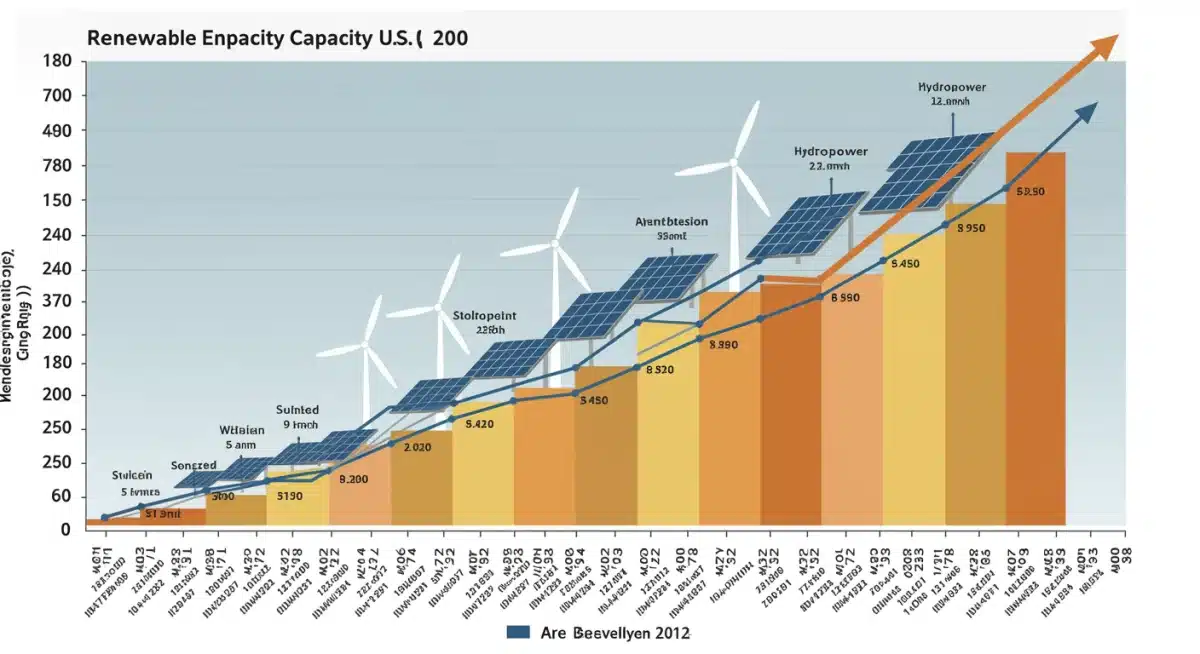

Solar and Wind Leading the Charge
Solar and wind energy continue to be the primary drivers of renewable growth. Technological advancements have made these sources more efficient and cost-effective, attracting substantial investment. Large-scale solar farms and offshore wind projects are becoming increasingly common, pushing the boundaries of what’s possible in clean energy generation.
- Cost Reductions: The levelized cost of electricity (LCOE) for solar and wind has dropped significantly, making them competitive with traditional fossil fuels.
- Technological Innovation: Advances in panel efficiency, turbine design, and smart grid technologies are continuously improving performance.
- Job Creation: The renewable energy sector is a major source of new jobs, contributing to economic growth across various states.
Challenges in Grid Modernization and Storage
Despite the rapid growth, the existing grid infrastructure was largely designed for centralized, fossil fuel-based generation. Integrating distributed renewable sources requires substantial upgrades, including smart grid technologies, increased transmission capacity, and robust energy storage solutions. Without these, the full potential of renewable energy cannot be realized.
Federal and State Policy Drivers for Rapid Deployment
Federal and state policies are critical in driving the rapid deployment of renewable energy technologies. The synergy between national incentives and localized regulations creates a powerful framework for accelerating the transition. The next 12 months will test the efficacy and coordination of these policy drivers.
At the federal level, the IRA provides a broad suite of incentives, from production tax credits to investment tax credits, designed to spur domestic manufacturing and deployment. States are complementing these efforts with their own renewable portfolio standards (RPS), clean energy mandates, and localized grant programs, according to the National Conference of State Legislatures (NCSL).
The Inflation Reduction Act’s Impact
The IRA, signed into law in August 2022, is arguably the most significant climate legislation in U.S. history. It allocates hundreds of billions of dollars towards clean energy and climate initiatives, aiming to reduce carbon emissions by approximately 40% below 2005 levels by 2030. Its provisions are designed to accelerate the deployment of solar, wind, and battery storage, while also boosting domestic manufacturing capabilities.
State-Level Initiatives and Their Role
Many states have set their own ambitious clean energy goals, often exceeding federal targets. These state-level policies, such as California’s 100% clean electricity by 2045 or New York’s 70% renewable electricity by 2030, create localized markets and drive innovation. The interplay between federal incentives and state mandates is crucial for a comprehensive national transition.
- Renewable Portfolio Standards (RPS): Mandate that a certain percentage of electricity come from renewable sources.
- Net Metering Policies: Encourage rooftop solar by allowing customers to sell excess power back to the grid.
- Clean Energy Funds: Provide financial support for renewable energy projects and research.
Technological Advancements and Innovation Pipeline
The pace of technological advancement in renewable energy is accelerating, offering new solutions and efficiencies that can significantly aid the U.S. transition. From enhanced solar panels to advanced battery storage and smart grid technologies, innovation is a key enabler for meeting ambitious goals within the critical 12-month timeframe.
Researchers and private companies are continuously pushing the boundaries of what’s possible. Breakthroughs in materials science are leading to more efficient and durable solar cells, while improvements in battery chemistry are yielding longer-lasting and more cost-effective energy storage solutions. These innovations are not just theoretical; many are on the cusp of commercial deployment, as reported by leading energy research institutions.
Next-Generation Solar and Wind Technologies
Beyond traditional silicon solar panels, emerging technologies like perovskite solar cells promise higher efficiencies and lower manufacturing costs. Similarly, advancements in wind turbine design, including taller towers and larger blades, are increasing energy capture and reducing the cost of wind power. Floating offshore wind platforms are opening up new geographic areas for development.
Breakthroughs in Energy Storage
Battery technology, particularly lithium-ion, has seen remarkable improvements in recent years. However, research into alternative storage methods, such as solid-state batteries, flow batteries, and even green hydrogen, is progressing rapidly. These diverse storage solutions are essential for addressing the intermittency of renewable sources and ensuring grid stability, especially as the share of renewables grows.
Economic Opportunities and Job Creation
The U.S. renewable energy transition is not just an environmental imperative; it also represents a significant economic opportunity, poised to create millions of jobs and stimulate investment across various sectors. The next 12 months will see a surge in demand for skilled labor and innovative businesses as projects accelerate.
According to the Department of Energy, the clean energy sector already employs hundreds of thousands of Americans, and this number is projected to grow substantially. Investments in manufacturing, installation, and maintenance of renewable energy infrastructure are driving economic development in communities nationwide. This growth creates a ripple effect, supporting local businesses and fostering new industries.
Upskilling the Workforce for Green Jobs
The shift towards a clean energy economy necessitates a skilled workforce. Educational institutions and vocational training programs are adapting to meet this demand, offering courses in solar panel installation, wind turbine maintenance, battery technology, and smart grid management. These programs are vital for ensuring that American workers are prepared for the jobs of the future.
Investment and Domestic Manufacturing Boom
Federal incentives, coupled with private sector investment, are sparking a resurgence in domestic manufacturing for clean energy components. From solar panels and wind turbine parts to electric vehicle batteries, companies are establishing new production facilities in the U.S., reducing reliance on foreign supply chains and creating high-quality manufacturing jobs. This localization strengthens the national economy and enhances energy security.
Overcoming Hurdles: Infrastructure and Permitting
Despite the strong policy tailwinds and technological advancements, significant hurdles remain in infrastructure development and permitting processes. Addressing these challenges within the next 12 months is paramount for the U.S. to hit its renewable energy targets and ensure a smooth transition. Delays in these areas can significantly slow deployment.
The existing electrical grid often lacks the capacity to transmit large amounts of renewable energy from remote generation sites to urban demand centers. Furthermore, the complex and often lengthy permitting processes for new transmission lines and renewable energy projects can cause significant delays. Streamlining these procedures while ensuring environmental protection is a delicate but necessary balancing act, as noted by various industry advocacy groups.
Grid Expansion and Modernization Needs
To accommodate the influx of renewable energy, the U.S. grid requires substantial expansion and modernization. This includes building new high-voltage transmission lines, upgrading existing infrastructure with smart grid technologies, and enhancing grid resilience against extreme weather events. These projects are capital-intensive and often face local opposition, making rapid progress challenging.
- Transmission Bottlenecks: Insufficient transmission capacity prevents renewable energy from reaching consumers efficiently.
- Aging Infrastructure: Much of the current grid is outdated and not designed for two-way power flow from distributed generation.
- Cybersecurity Risks: A modernized, interconnected grid requires robust cybersecurity measures to prevent disruptions.
Streamlining Permitting and Siting
The current permitting process for large-scale energy projects, including renewables and transmission lines, can take years. Environmental reviews, public consultations, and inter-agency coordination often lead to significant delays. There is a growing consensus among policymakers and industry stakeholders that these processes need to be streamlined without compromising environmental standards or community engagement.
| Key Aspect | Current Status & Urgency |
|---|---|
| Policy Implementation | Federal incentives like the IRA require swift project initiation to maximize benefits within their timelines. |
| Grid Modernization | Urgent upgrades and expansion are needed to integrate growing renewable capacity and ensure reliability. |
| Permitting Streamlining | Expediting project approvals is critical to avoid delays in renewable energy deployment and infrastructure build-out. |
| Investment & Workforce | Increased investment and a skilled workforce are essential to capitalize on economic opportunities and meet demand. |
Frequently Asked Questions About the U.S. Renewable Energy Transition
The next 12 months are critical due to expiring tax credit windows, the need to demonstrate progress on climate commitments, and the rapid pace required to build out infrastructure. Delays now could lead to significantly higher costs and missed climate targets in the future.
The Inflation Reduction Act (IRA) is the primary federal driver, offering extensive tax credits and incentives. Additionally, various state-level renewable portfolio standards (RPS) and clean energy mandates complement these federal efforts, pushing localized deployment and innovation.
Key challenges include modernizing and expanding the aging electrical grid, streamlining complex permitting processes for new projects, and developing sufficient energy storage solutions to manage the intermittency of solar and wind power effectively.
The transition is expected to create millions of new jobs in manufacturing, installation, and maintenance across the clean energy sector. It will also attract significant investment, foster domestic manufacturing capabilities, and stimulate economic growth in various communities nationwide.
Consumers can contribute by adopting rooftop solar, choosing renewable energy options from their utility, investing in energy-efficient appliances, and supporting policies that promote clean energy. Their demand helps drive market growth and technological adoption.
What Happens Next
The next 12 months will be a period of intense activity and critical decision-making for the U.S. renewable energy transition. Watch for accelerated project announcements, particularly in solar and offshore wind, as developers aim to capitalize on existing incentives. Legislative efforts to streamline permitting are also expected to gain traction, potentially impacting the speed of new infrastructure development. The outcome of these efforts will not only dictate the nation’s ability to meet its climate pledges but also shape its global leadership in the burgeoning clean energy economy. The clock is ticking, and the world is watching for tangible progress.
